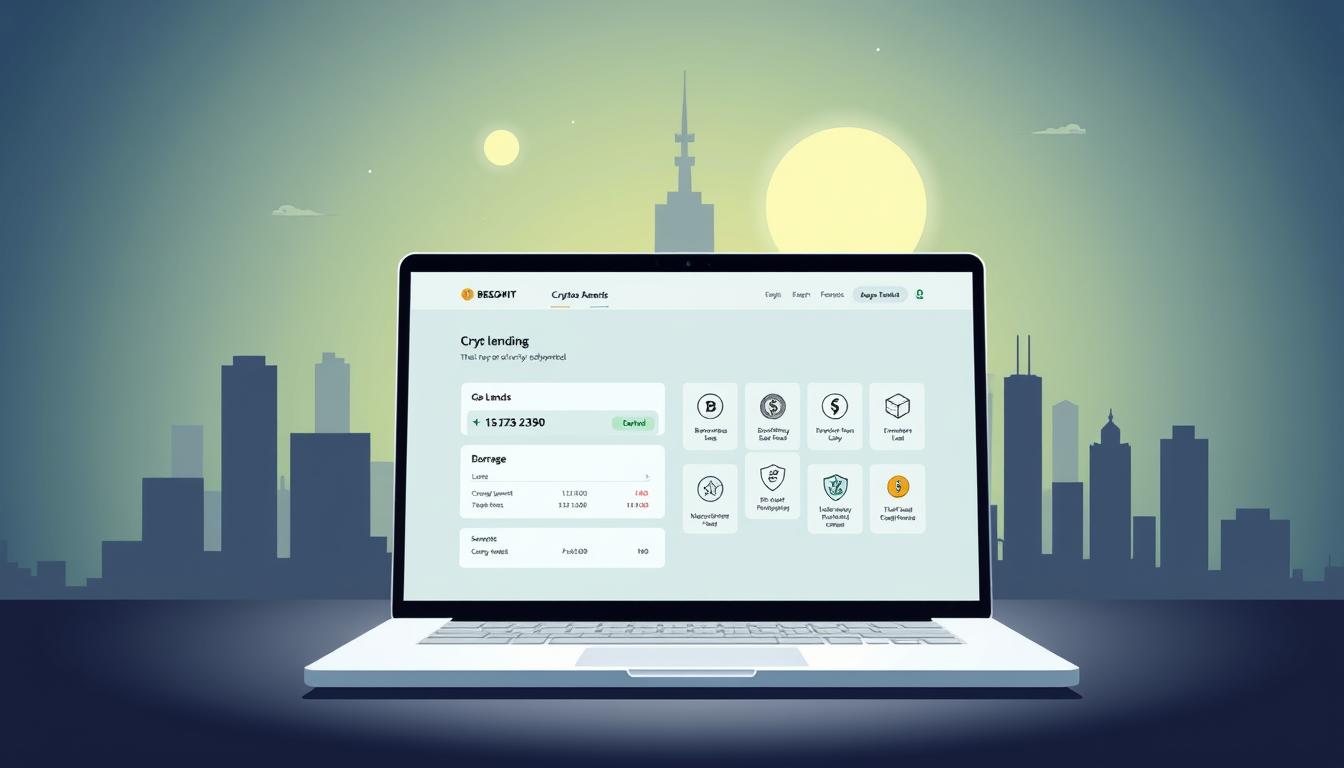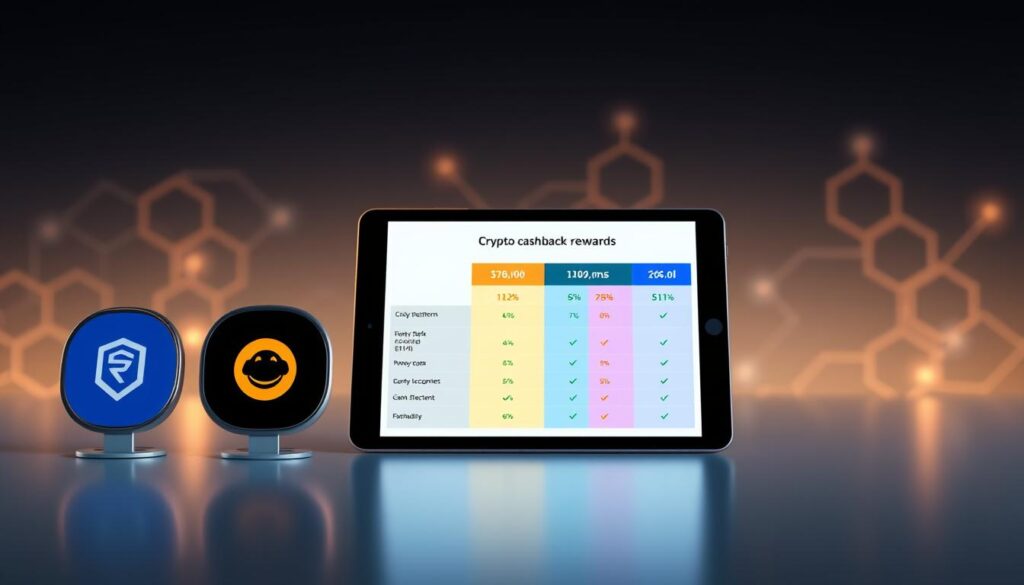Now Reading: Crypto Lending Platforms: A Review of Top Options
- 01
Crypto Lending Platforms: A Review of Top Options
Crypto Lending Platforms: A Review of Top Options
The digital finance landscape is evolving fast, and innovative tools are reshaping how people manage assets. One standout development connects investors seeking passive income with borrowers needing quick funds—all without selling holdings. This system combines flexibility with modern financial needs, offering opportunities beyond traditional banking.

These services stand out for their accessibility. Unlike conventional loans, they often skip credit checks and lengthy approvals. Users can earn returns that outperform standard savings accounts while maintaining ownership of their assets. Whether covering unexpected expenses or funding new ventures, liquidity arrives swiftly.
Two models dominate this space: centralized (CeFi) and decentralized (DeFi) systems. CeFi options act as intermediaries, managing transactions through trusted institutions. DeFi alternatives use automated protocols, letting users interact directly via smart contracts. Both paths have unique benefits, which we’ll explore in detail later.
Choosing the right service requires evaluating factors like interest rates, security protocols, and supported currencies. For those exploring leading crypto lending platforms, understanding these elements ensures smarter decisions aligned with personal goals and risk tolerance.
Key Takeaways
- Digital finance tools bridge investors and borrowers efficiently
- Centralized (CeFi) and decentralized (DeFi) models offer distinct advantages
- Potential returns often exceed traditional savings accounts
- Quick liquidity access supports diverse financial needs
- Security and asset variety are critical selection factors
- This guide prepares readers to identify their ideal solution
Understanding the Mechanics of Crypto Lending
Modern financial systems now let users unlock value from stored digital wealth without selling positions. Borrowers secure funds by locking their holdings as collateral, while lenders earn interest through automated agreements. This system hinges on loan-to-value (LTV) ratios, which determine borrowing limits and liquidation thresholds if asset values drop sharply.

How Collateral-Based Loans Operate
Users deposit digital assets into a service, receiving funds based on a percentage of their value. For example, a $10,000 Bitcoin deposit might secure a $6,000 loan at 60% LTV. Repayment terms vary, but failing to maintain the required ratio triggers automatic asset sales. Lenders contribute to liquidity pools, earning returns from borrower payments.
Centralized vs Decentralized Models
Centralized services like Binance manage transactions and hold collateral, offering customer support and regulatory safeguards. In contrast, decentralized protocols like Aave use smart contracts to connect users directly. While CeFi simplifies navigation for beginners, DeFi grants full control over assets—demanding technical know-how to manage risks.
Interest rates fluctuate based on supply, demand, and market volatility. CeFi often provides fixed rates, while DeFi uses algorithms adjusting in real time. Both models require careful evaluation of security measures and asset compatibility before committing funds.
Evaluating Leading Lending Platforms
Navigating the expanding ecosystem of digital asset services requires understanding how top solutions balance flexibility with reliability. Let’s explore how industry leaders stand out through specialized tools and security frameworks.

Features and Unique Offerings
Binance Loans supports over 30 currencies with minute-by-minute rate adjustments, ideal for short-term strategies. Aave’s flash loans enable instant borrowing without collateral—perfect for arbitrage opportunities. CoinRabbit shines with 90% LTV ratios, the highest in our comparison.
Specialized services like Unchained Capital focus exclusively on Bitcoin, offering collaborative custody for added security. Alchemix introduces self-repaying loans, using yield farming to automatically reduce debt. These innovations demonstrate how providers cater to niche demands.
User Experience and Platform Security
Beginners often prefer Binance’s intuitive dashboard, while DeFi veterans value Aave’s cross-chain compatibility. Clear navigation menus and real-time balance tracking are common among top-rated services.
Security protocols vary significantly. CoinRabbit uses multi-signature wallets and monthly audits, whereas Compound relies on decentralized governance. Most providers now offer two-factor authentication and cold storage for digital holdings. Always verify insurance coverage before depositing assets.
Comparing Interest Rates, LTV Ratios, and Loan Terms
When evaluating financial tools, three metrics stand out as critical differentiators. Annual percentage rates (APRs) reveal the true cost of borrowing, while loan-to-value (LTV) ratios define risk exposure. Repayment structures determine how quickly obligations must be settled.

Decoding APR and Loan-to-Value Metrics
APRs fluctuate based on asset volatility and market demand. YouHodler offers rates from 12% to 26.07% with LTVs reaching 97% for select assets. In contrast, Compound keeps stablecoin rates below 4% with 80% LTV caps.
Bitcoin-focused services like Unchained Capital show how collateral types affect terms. Their 70% LTV and 14%+ APR reflect Bitcoin’s stability versus newer assets. Wirex maintains 8% rates for ETH/BTC borrowers, balancing accessibility with risk management.
Flexibility in Repayment Terms
Alchemix redefines deadlines through self-repaying loans using yield farming. Crypto.com rewards CRO stakers with 8% rates, while standard users face higher costs. Most providers allow early repayment without penalties.
Loan durations range from 30 days to indefinite periods. Minimum amounts start under $100, appealing to small investors. For a comprehensive platform comparison, analyze how these variables align with your financial strategy.
Assessing Benefits and Risks in Crypto Loans
Balancing opportunity with caution becomes essential when using digital assets for financial strategies. While these tools offer unique advantages, understanding potential pitfalls helps users make informed choices. Let’s break down the key factors to consider.
Advantages Over Traditional Lending
Accessing funds without selling assets helps investors avoid capital gains taxes. Loans secured by collateral skip credit checks, offering faster approvals than banks. This method also lets traders amplify positions by reinvesting borrowed funds during market upswings.
Risks: Volatility, Liquidation, and Platform Limitations
Sudden price drops can trigger automatic collateral sales, eroding holdings. Centralized services face operational risks—three major providers collapsed in 2022, locking users out of funds. Decentralized options carry smart contract vulnerabilities, where coding errors might drain assets.
No government insurance protects these investments, unlike FDIC-covered bank accounts. Always assess a service’s audit history and liquidity reserves. Diversifying across multiple providers reduces exposure to single-point failures.
Key Considerations When Choosing a Crypto Lending Platform
Selecting the right service for digital asset management demands careful evaluation of multiple factors. Prioritizing security and operational transparency helps users avoid common pitfalls while maximizing returns.
Security, Reputation, and Customer Support
Top-tier services employ cold storage for 95% of holdings and multi-signature wallet access. Look for platforms with:
- Third-party audit certifications like CertiK
- Insurance coverage exceeding $100 million
- 24/7 live support for urgent issues
Reputation checks should include regulatory filings and founder backgrounds. Centralized options typically offer phone support, while decentralized systems rely on community forums. Always verify response times through user testimonials.
Asset Support and Collateral Options
Services vary widely in supported currencies. Some accept only Bitcoin and Ethereum, while others handle 100+ altcoins. Consider these elements:
- Collateral flexibility (single vs. multi-asset pools)
- Loan terms matching your investment horizon
- Geographical restrictions affecting access
Ask providers about withdrawal limits and lock-up periods. Transparent platforms display real-time LTV ratios and interest rate changes. Diversify across multiple services to reduce exposure to any single point of failure.
Comparing Crypto Lending Platforms
Selecting the right digital asset service requires matching specific needs to platform strengths. DeFi options like Aave dominate flexibility, offering flash loans and multi-chain support with rates adjusting every block. Its 80% collateral ratio suits experienced users comfortable with market swings.
Centralized alternatives shine for accessibility. Binance supports 30+ assets with instant approvals, though unavailable in major English-speaking markets. CoinRabbit stands out with 90% LTV ratios – the highest ceiling we analyzed – paired with 70+ supported currencies.
Specialized Solutions Emerge
Unique offerings cater to niche demands. Unchained Capital focuses solely on Bitcoin, requiring $10k minimum but providing collaborative custody security. Alchemix revolutionizes repayment through yield-generated debt reduction, ideal for long-term holders.
Interest rates vary dramatically. YouHodler charges up to 26.07% APR but permits 97% collateral usage. Crypto.com rewards loyal users, slashing rates to 8% for CRO token stakers. Always verify geographic restrictions – Wirex serves BTC/ETH borrowers globally, while others block U.S. users.
Final choices should balance LTV ratios, asset diversity, and repayment models. Prioritize platforms with transparent audits and responsive support teams to safeguard your digital holdings.
FAQ
How do bitcoin-backed loans differ from traditional bank loans?
Bitcoin-backed loans use digital assets like BTC as collateral instead of credit checks. This allows faster approval, global access, and no need to sell holdings. Traditional loans often require lengthy applications and income verification.
What happens if my collateral’s value drops below the LTV ratio?
Platforms may issue a margin call or automatically liquidate part of your holdings to maintain the loan-to-value threshold. Monitoring market conditions and choosing conservative LTV ratios reduces this risk.
Are interest rates fixed or variable on decentralized platforms like Aave?
Rates on DeFi platforms typically fluctuate based on supply and demand. For example, Compound adjusts APYs algorithmically, while CeFi services like BlockFi sometimes offer fixed-rate options.
Can I use multiple types of digital assets as collateral?
Yes. Leading platforms like Celsius and Nexo support Ethereum, stablecoins, and altcoins alongside bitcoin. Always verify which assets qualify before depositing.
How do tax implications work for loans using crypto collateral?
In most jurisdictions, borrowing against holdings isn’t a taxable event. However, liquidations or selling collateral might trigger capital gains. Consult a tax professional for specific cases.
What security measures protect against platform hacks?
Reputable services use cold storage, multi-sig wallets, and insurance funds. DeFi protocols like MakerDAO employ smart contract audits. Research each platform’s track record before depositing funds.
Is there a minimum loan amount on platforms like Binance?
Minimums vary. Binance requires at least 0.01 BTC, while BlockFi starts at ,000. Compare terms across providers to match your liquidity needs.
Can I repay loans early without penalties?
Many platforms allow early repayment, but some charge fees. For instance, YouHodler offers flexible terms, while certain DeFi protocols enforce fixed durations.













